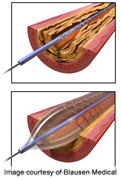
MONDAY, Oct. 7 (HealthDay News) — Which heart patients receiving artery-opening stents are at highest risk for heart attack, stroke or other issues if they undergo a noncardiac surgery soon after the procedure?
A new study pinpoints two groups at especially elevated risk: those who underwent the surgery on an emergency basis, and patients with advanced forms of heart disease.
A stent is a small mesh tube, either of a bare-metal or drug-coated (“eluting”) type, that is inserted into an artery to help prop it open. Doctors typically urge that patients forgo nonessential, noncardiac surgeries for at least a year after stent implantation.
In the new study, researchers analyzed 2000-2010 data from U.S. patients who underwent noncardiac surgery — for example, knee replacement, respiratory or digestive system surgeries — within two years of receiving a stent.
Close to 5 percent of these patients went on to have major heart problems within a month of their surgery. These problems included heart attack, death and the need for another procedure to open heart arteries.
The three major risk factors for major heart problems were: having the surgery on an emergency basis, having had a heart attack in the six months before the surgery, and having advanced heart disease, according to a team led by Dr. Mary Hawn, of the University of Alabama at Birmingham.
The rate of such heart problems was about 5 percent for people who received bare-metal stents and 4.3 percent for drug-eluting stents. Drug-eluting stents, which are typically more expensive than bare-metal versions, emit medicines that help prevent artery reclosure.
The type of stent received was not associated with major heart problems occurring more than six months after stent placement.
The study was published Oct. 7 in the Journal of the American Medical Association and was to be presented on Monday at the annual Clinical Congress of the American College of Surgeons, in Washington, D.C.
Hawn’s team noted that about 600,000 stenting procedures are carried out in the United States each year, and “12 to 23 percent of these patients [also] undergo noncardiac surgery within two years of coronary stent placement.”
The researchers pointed out that noncardiac surgery after recent coronary stent placement is associated with increased risk of major heart problems, but delaying necessary surgery can be a dilemma for a large number of patients.
“Guidelines recommend delaying noncardiac surgery in patients after coronary stent procedures for one year after drug-eluting stents and for six weeks after bare-metal stents. The evidence underlying these recommendations is limited and conflicting,” the study authors wrote.
One heart expert said that decisions around the timing of noncardiac surgeries for heart patients are complicated, especially when it comes to the use of anti-clotting drugs.
“Patients getting stents are usually in an age group that has lots of health issues,” explained Dr. Kirk Garratt, director of interventional cardiovascular research at Lenox Hill Hospital in New York City. “Some of these people will need surgery in the months that follow a stent. Withholding anti-platelet medicines after six weeks for bare-metal stents, and after six months for drug-eluting stent, is safe,” he said.
“The trick is knowing what to do with the ones that need surgery in a shorter period of time,” Garratt added. “If a stent is in a key location, like the left main artery, we hospitalize the patient and use IV blood thinners until a few hours before surgery. We turn the blood thinners back on as soon as we can. Some newer drugs, like cangrelor, can be very useful for these patients,” he explained.
“It’s tricky: we want to offer the benefit of drug-eluting stents when we can, but we can’t always identify patients who will need to stop their anti-platelet medicines early,” Garratt said. “If we guess wrong, it can be hard-going for some patients.”
In an accompanying journal editorial, experts said the findings may not alter the status quo for many patients.
“The approach for patients with bare-metal stents should not change; these patients usually can undergo surgery within six weeks after coronary stent implantation with very low risk of stent thrombosis,” Dr. Emmanouil Brilakis and Dr. Subhash Banerjee of the VA North Texas Health Care System in Dallas wrote.
For patients with drug-eluting stents, surgeries carried out six months or more after the implantation of the stent appear to have a very low risk for re-closure of the stent, the editorialists added. “Hence, nonurgent operations should be postponed until six months after stent implantation,” they said.
More information
The U.S. National Heart, Lung, and Blood Institute has more about stents.
Copyright © 2025 HealthDay. All rights reserved.

